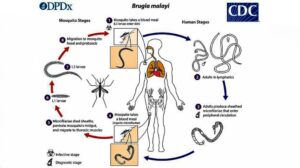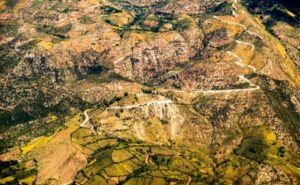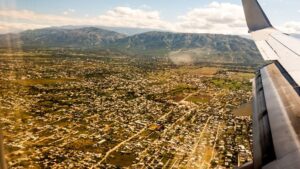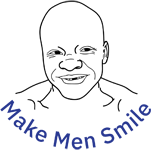Today we eagerly waited at the airport to go from Miami to Port-au-Prince, the capital city of Haiti. Haiti, located on the Caribbean next to the Dominic Republic, is the first independent country in South America and also the poorest country in the Western Hemisphere. Ten years ago, the epicenter of the disastrous earthquake was near Port-au-Prince, causing most houses to collapse and nearly 500,000 casualties. The city is still under reconstruction. Due to the polluted water sources and high prevalence of infectious diseases in Haiti, we prepared vaccinations for hepatitis A, hepatitis B, hepatitis C, tetanus, and typhoid fever. We also brought anti-diarrhea and anti-mosquito medication.
This was the first time that Annie and I joined the Make Men Smile program on a medical mission to Haiti. Make Men Smile is a program founded by Dr. Steven Shu in 2017. The objective of Make Men Smile is to perform hydrocelectomy for patients suffering from lymphatic filarial hydroceles in order to relieve their suffering from the disease, help them regain self-esteem, familial harmony, and labor ability. More details about the program can be found at www.makemensmile.org.
 Lymphatic filarial hydrocele is fluid accumulation in the scrotum, a sequela of acute lymphatic filariasis, which is transmitted by mosquitos. This disease is very rare in the United States, but quite common in Haiti. Its prevalence in Haiti is due to three main factors: The year round hot and humid environment that promotes mosquito breeding; the poor health care systems in Haiti that are unable to meet the medical need of Haitians; and that most people cannot afford their medical care. As the fluid in the scrotum accumulates, the symptoms get worse as time goes by. A large hydrocele not only affects patients’ daily lives, but also causes the loss of labor capacity, which causes even more financial strain on the families affected.
Lymphatic filarial hydrocele is fluid accumulation in the scrotum, a sequela of acute lymphatic filariasis, which is transmitted by mosquitos. This disease is very rare in the United States, but quite common in Haiti. Its prevalence in Haiti is due to three main factors: The year round hot and humid environment that promotes mosquito breeding; the poor health care systems in Haiti that are unable to meet the medical need of Haitians; and that most people cannot afford their medical care. As the fluid in the scrotum accumulates, the symptoms get worse as time goes by. A large hydrocele not only affects patients’ daily lives, but also causes the loss of labor capacity, which causes even more financial strain on the families affected.
Hydrocelectomy is a surgical operation to cure this disease that costs about $200. The procedure can fundamentally change both the patients’ lives and their families’ lives. It brings smiles to the suffering Haitian men and their entire family.
 American Airlines has daily flights from Miami to Port-au-Prince. Our flight was packed with many Haitians returning home and volunteers going to Haiti to help with house building and schools. We were the only medical volunteers on board. Our team leader was Dr. Steven Shu, a plastic surgeon and office procedurist from Minnesota. The other members were Dr. Fran Yu, a family practice physician from New Jersey; Dr. Poreider, an Obstetric and Gynecologist in China; and me, an anesthesiologist from Maryland. I knew this was going to be a special journey.
American Airlines has daily flights from Miami to Port-au-Prince. Our flight was packed with many Haitians returning home and volunteers going to Haiti to help with house building and schools. We were the only medical volunteers on board. Our team leader was Dr. Steven Shu, a plastic surgeon and office procedurist from Minnesota. The other members were Dr. Fran Yu, a family practice physician from New Jersey; Dr. Poreider, an Obstetric and Gynecologist in China; and me, an anesthesiologist from Maryland. I knew this was going to be a special journey.
When the plane flew over the Caribbean Sea, the water of the sea was as blue as jasper! The water was so clear that even some small islands underwater could be seen clearly. I suddenly had an urge to swim a few laps in the water. From an aerial view over Haiti, most of Haiti was mountainous. There were some planting fields on top of the mountains, and the winding path seems to be unsuitable for large trucks driving through.
The main agricultural products of Haiti are sugar canes, cocoa beans, corn, potatoes, and sweet potatoes. Old farming equipment, poor land quality, and poor management make Haiti’s agricultural products insufficient to meet the needs of its population. Haiti is far behind the development of modern industry and technology.
 This was a bird’s view of Port-au-Prince. It seemed that the city was being rebuilt. These houses looked like bungalows – there were no tall buildings nor big roads.
This was a bird’s view of Port-au-Prince. It seemed that the city was being rebuilt. These houses looked like bungalows – there were no tall buildings nor big roads.
I expected Haiti airport to be busy. But surprisingly, it had only one runway. After our plane landed, it taxied to the end of the runway and then turned 180-degree to the gate. There was only one plane parked in the airport. Maybe this was due to COVID-19 pandemic. As soon as the cabin door opened, a heat wave hit us. It was in December, and the temperature outside was about 90 degrees Fahrenheit!
When we got through customs, we paid a $10 tourism fee even though we were not ordinary tourists.
As soon as we exited the airport, many people rushed up to carry our luggage. We were startled. Fortunately, Dr. Jolius, our contact person in Haiti, took us to the cars quickly. Dr. Shu paid some cash to get these people away.
 The roads were dusty, narrow, and bumpy. Most people did not follow traffic rules. Cars, bicycles, and motorcycles were coming from all directions. Fortunately, the traffic was slow so there were no accidents.
The roads were dusty, narrow, and bumpy. Most people did not follow traffic rules. Cars, bicycles, and motorcycles were coming from all directions. Fortunately, the traffic was slow so there were no accidents.
There were many small stalls on both sides of the road. These shops sold shoes, snacks, clothes, and daily necessities. There were also some repair shops for bicycles and cars. This reminded me of China’s rural country in mid 1970s and early 1980s.
Their buses were interesting, painted in bright colors, very distinguishable and easy to spot. The buses moved slowly and people just hopped on and off the buses as they pleased. The windows of the buses were open which was helpful with air circulation. The buses usually were crowded with people. Some wore masks, some didn’t.

This was how the Haitians carry merchandise: a basin over their heads. They had good balancing skills, sometimes they didn’t even hold the basin, and the basin would not fall! I was impressed. I visualized these heavy objects as symbols of the social burdens upon them. But look at how they walked! Their heads held up high and their backs straight. They walked with dignity! And they lived in dignity.
People wore decent clothes. Ladies wore sexy dresses, and men wore T-shirts or long-sleeved shorts. The students wore neat school uniforms.
Most of the houses were quite new but some were unfinished. Occasionally some houses were quite nice looking, surrounded by iron fences. The road was dusty. The houses and trees nearby were covered with thick layers of dust. Even the air was filled with dust.
There were some stalls selling paintings on the roadside. These paintings had heavy colors and bold brushstrokes. The contents of the paintings included models, abstract, landscapes, religious works, and their daily lives. These works were painted on fabric and hung on ropes. Wind blew and the painting waved. Art is of human nature; it has nothing to do with wealth or poverty. Even in a poor country like Haiti, people still enjoy arts!
The driver took us to a store and asked if we wanted to buy groceries. Two security guards with rifles were patrolling back and forth. This reminded me that Haiti was not a safe haven, rioting or violence could happen.
 Finally, we reached our destination. The surgical center, a nearby hospital, our guest house, and a school were all located within a large courtyard with a big iron gate. The gate opened when our cars entered. There were security guards. On the left was the surgical center where we would do our work for the next few days. On the right was the hospital, still under construction. Our guesthouse had three floors that were built by HCM (Haitian Christian Mission) for the use of medical mission teams and missionaries.
Finally, we reached our destination. The surgical center, a nearby hospital, our guest house, and a school were all located within a large courtyard with a big iron gate. The gate opened when our cars entered. There were security guards. On the left was the surgical center where we would do our work for the next few days. On the right was the hospital, still under construction. Our guesthouse had three floors that were built by HCM (Haitian Christian Mission) for the use of medical mission teams and missionaries.
We were eager to visit the surgical center and operation rooms. I needed to mentally prepare for the next few days’ operations.
The surgical center was built and managed by an American physician Dr. Higgins, and was named Higgins Brothters Surgicenter for Hope. Part of the center was used as an emergency room, providing 24 hours medical services for residents in nearby mountainous areas.
Dinner was good. Haitian food was similar to Mexican food. The hostess in charge of the guesthouse was Claudette. She was a tall and strong woman who didn’t speak English. When she saw us, she broke out a big smile and quickly took the food out from the warm oven on table. I felt so warm and welcomed.
This was our first day in Haiti.
